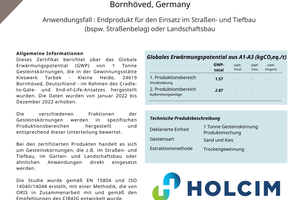Holcim Germany: Transparency
for aggregates such as sand, gravel
and chippings
The need for information on the environmental impact of building materials is growing rapidly. The comparability of different products and their impact on the climate and nature is becoming increasingly important for various stakeholder groups: public building owners are keen to take the global warming potential and climate resilience of infrastructure into account during planning and to limit emissions over the entire life cycle. Investors in building construction are also increasingly demanding information on sustainability parameters due to the EU Taxonomy Regulation. Future regulations will take this into account: from 2027, manufacturers of construction products will probably have to report the global warming potential of their products. In addition, there are already efforts to include a “shadow price” for CO2 emissions in future tenders.
Holcim Germany is the first building materials manufacturer that can already provide scientifically sound evidence of the product-specific CO2 footprint of all aggregates from ten plants. This is made possible by the CO2 calculator from Oris Materials Intelligence, which was developed in accordance with the recommendations of Ciraig, a leading global LCA research center based in Montreal (Canada). The results are standard-compliant and scientifically sound. In addition, the tool was tailored to the specific needs of the industry in collaboration with the Bundesverband Mineralische Rohstoffe e.V. (Federal Association of Mineral Raw Materials). Holcim has made a conscious decision to take the lead on this issue today, without any legal obligation, in order to actively drive the development towards sustainability and transparency. Against this background, the calculation of these ten plants, where natural stone as well as sand and gravel are quarried, is only the first step. The remaining production sites will follow successively, including prefabricated and recycled products.
“We are proud to be the first company in the industry to be able to disclose product-specific emissions,” comments Tilo Hahn, Head of Aggregates at Holcim Germany. “We are convinced that transparency must be the first prerequisite for the comparability of building materials and the basis for the sustainable construction of the future - individually for each product. In addition to the technical, logistical and commercial sales components, we will now also convince our customers with the transparency of emissions in the overall package.”
Data is systematically evaluated and processed when calculating the carbon footprint. This includes specific data from business operations on the one hand and the CO2 equivalents of the various greenhouse gases on the other. The calculation method is based on the Life Cycle Assessment Methodology, or LCA for short, and is in line with the DIN EN 15804+A2 and ISO 21930 standards. A comprehensive and systematic analysis of a product‘s global warming potential is carried out. This is a global approach that covers the life cycle phases of extraction, transportation and processing of raw materials as well as the end-of-life phases. A particular focus is on determining the carbon footprint for each product in the plant.
This data has so far been collected for ten Holcim plants and calculated for the products manufactured there. However, this marks only a first milestone, as the other sites will follow successively and very soon.
“We are delighted that Holcim Germany has decided to use the Oris CO2 calculator for aggregates to systematically calculate the CO2 footprint of its entire product portfolio. The first ten plants mark a milestone. With our innovative solution, the construction industry is accelerating its digital and sustainable transformation by considering the environmental impact on a product-by-product basis,” explained Nicolas Miravalls, CEO of Oris.
The following ten plants are making the start: Barnten, Blasbach, Goldbeck, Medenbach, Niederweimar, Saalburg, Schalkholz, Tarbek, Tönisvorst, Wilhelmshaven.





